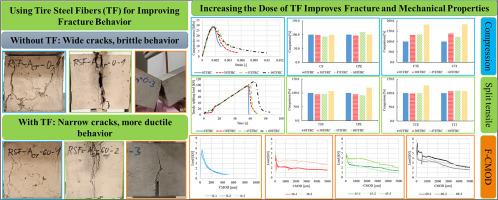Assessing the impact of tire steel fibers on concrete’s fracture behavior, cracking resistance, and durability performance
IF 2.9
Q2 MATERIALS SCIENCE, MULTIDISCIPLINARY
引用次数: 0
Abstract
The accumulation of waste tires in landfills poses a significant environmental challenge that requires innovative solutions, one of which involves incorporating tire components into concrete. Concrete reinforced with tire steel fibers (TF), TFRC, demonstrates enhanced properties, including improved fracture mechanics, rheological behavior, water absorption, and CO2 absorbency. While the effects of TFs have been widely studied in low-strength concrete (20–25 MPa), mortars, and self-compacting concrete, their influence on high-strength concrete (C40/50) remains underexplored. Previous studies suggest that TFs could exhibit enhanced performance in high-strength concrete due to their strong bond with the binder. Addressing this gap, the present study evaluates the impact of TFs on concrete with compressive strengths of 40–45 MPa, using TF dosages of 0–60 kg/m3. The TFs were sourced from a local processing plant in Bratislava. The study evaluates various properties, including compressive strength (CS), modulus of elasticity (EM), tensile splitting strength (TSS), modulus of rupture (MoR), residual stresses, fracture energy, linear shrinkage (LS), water absorption (WA), and carbonation. Results show that concrete with a 60 kg/m3 dosage of TF exhibited notable improvements over plain concrete, with increases in CS (+3.8 %), TSS (+6.7 %), MoR (+4.1 %), and a reduction in linear shrinkage (−5.5 %). Additionally, fracture energy was significantly higher in all TFRC mixtures compared to plain concrete. Empirical models were developed to predict the linear shrinkage and carbonation of TFRC. The findings highlight the potential of TFRC to enhance the mechanical performance and sustainability of infrastructure, offering a competitive alternative to other metallic fibers.

评估轮胎钢纤维对混凝土断裂行为、抗裂性和耐久性性能的影响
废弃轮胎在垃圾填埋场的堆积对环境构成了重大挑战,需要创新的解决方案,其中之一就是将轮胎部件融入混凝土中。用轮胎钢纤维(TF) (TFRC)加固的混凝土表现出增强的性能,包括改善断裂力学、流变行为、吸水率和二氧化碳吸收性。虽然TFs对低强度混凝土(20-25 MPa)、砂浆和自密实混凝土的影响已被广泛研究,但它们对高强混凝土(C40/50)的影响仍未得到充分探讨。先前的研究表明,由于TFs与粘合剂的牢固结合,它可以在高强度混凝土中表现出增强的性能。为了解决这一问题,本研究评估了TF对抗压强度为40-45 MPa的混凝土的影响,使用的TF用量为0-60 kg/m3。TFs来自布拉迪斯拉发当地的一家加工厂。该研究评估了各种性能,包括抗压强度(CS)、弹性模量(EM)、拉伸劈裂强度(TSS)、断裂模量(MoR)、残余应力、断裂能、线性收缩率(LS)、吸水率(WA)和碳化。结果表明,与素混凝土相比,添加60 kg/m3掺量的TF混凝土表现出显著的改善,CS(+ 3.8%)、TSS(+ 6.7%)、MoR(+ 4.1%)增加,线收缩率降低(- 5.5%)。此外,与普通混凝土相比,所有TFRC混合物的断裂能都明显更高。建立了预测TFRC线性收缩和碳化的经验模型。研究结果强调了TFRC在提高基础设施机械性能和可持续性方面的潜力,为其他金属纤维提供了有竞争力的替代品。
本文章由计算机程序翻译,如有差异,请以英文原文为准。
求助全文
约1分钟内获得全文
求助全文
来源期刊

Materialia
MATERIALS SCIENCE, MULTIDISCIPLINARY-
CiteScore
6.40
自引率
2.90%
发文量
345
审稿时长
36 days
期刊介绍:
Materialia is a multidisciplinary journal of materials science and engineering that publishes original peer-reviewed research articles. Articles in Materialia advance the understanding of the relationship between processing, structure, property, and function of materials.
Materialia publishes full-length research articles, review articles, and letters (short communications). In addition to receiving direct submissions, Materialia also accepts transfers from Acta Materialia, Inc. partner journals. Materialia offers authors the choice to publish on an open access model (with author fee), or on a subscription model (with no author fee).
 求助内容:
求助内容: 应助结果提醒方式:
应助结果提醒方式:


